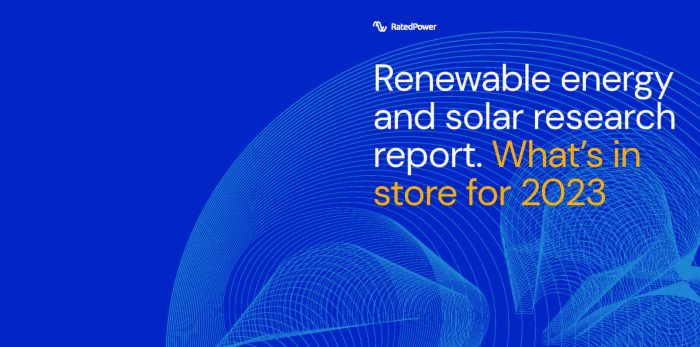
RatedPower, now a part of energy SaaS platform Enverus, has released its annual findings derived from nearly 100 diverse industry experts from across the world and more than 101,000 simulations. According to the results, the focus for 2023 will be on accelerating the adoption of renewable energy power generation, reducing the levelized cost of electricity, fuel diversification and energy storage investment.
After years of falling costs, the renewable industry faced new challenges in 2022 as supply chain disruptions related to the pandemic increased equipment prices and reduced availability, the report shows. But new global capacity installations continued to rise as the pandemic, coupled with the energy crisis, spurred governments and businesses to increase their investments in clean energy and reduce reliance on fossil fuel imports.
“In the year ahead, we expect the green transition to provide a massive boost to investments in solar photovoltaics (PV), for residential, commercial and industrial, and for utility-scale installations. The industry is increasingly looking at ways to incorporate battery storage and clean, green hydrogen into renewable installations to maximize supply,” said Andrea Barber, VP of power and renewables at Enverus and cofounder of RatedPower.
To gain further insight into the status of the industry and the key trends for this year and beyond, RatedPower turned to more than 100 experts from energy companies of all sizes from around the world and carried out a comprehensive survey that includes their views on the challenges and prospects ahead. Additionally, the report analyzes data from RatedPower’s solar plant simulation software to highlight key trends and top manufacturers around the world in 2022.
“The energy evolution is not clearly mapped out for us,” added Bernadette Johnson, general manager of power and renewables at Enverus. “It is a winding, twisting road full of potholes. All these twists, turns and bumps make the market one that is full of risk but, more importantly, of opportunity as well. At Enverus, we continue to work endlessly to eliminate the gaps and help you make intelligent connections between all parts of the project lifecycle from siting through operations, so you can minimize investment risks and maximize returns.”
Key themes revealed
Industry experts are concerned about instability and grid saturation. Grid saturation and instability has joined permitting and regulation as the biggest challenge the renewable industry is facing in the coming year, with both issues cited by 68% of respondents. The increase in costs is widely mentioned among the respondents as a major challenge. More than 40% of survey respondents have also cited the increasing lack of skilled personnel, land availability and raw materials.
Energy storage keeps gaining attention. When asked about technologies with the highest potential, experts still mention energy storage as a trendy topic, but agree that the future might be in newer PV technologies that contribute to the deployment of renewable capacity at the scale needed for global decarbonization. Agriphotovoltaics, floating PV, vehicle-integrated PV, and building-integrated PV are promoted as routes to expanding solar capacity.
U.S. and China are perceived as top growth potential regions. For the first time, the U.S. has overtaken China as the country with the highest growth potential, with 60% of responses placing it at the top, followed by China with 46%. India and Australia also made the list with their ambitious renewable plans.
The key to success: Diversification. Diversification of renewable energy is one of the top three key success factors of a leading energy company, according to 68.5% of respondents. Almost all industry professionals believe that automation, digitalization of the processes, and energy storage need to be the focus of investors to help with the grid saturation and instability challenges.
RatedPower: A deep dive into the data. There has been an increase in the volume of generation capacity simulated in RatedPower’s software to 9.47 TW across 101,822 simulations throughout 2022.
- The average rated power capacity worldwide in 2022 was around 96 GW, with the first quarter rising above 100 MW, up from 80.69 MW in 2021.
- The data shows an increase in the popularity of string inverters over central inverters for the past two years. The simulations based with these inverters are 53% and 47% respectively.
- Although solar tracking systems accounted for more than half of the simulations, there seems to be a growing trend towards the use of fixed structures, which increased by 3%.
- Top three countries by average rated power are Brazil (326.8 MW), México (162.6 MW) and Chile (161.95 MW).
- Bifacial modules simulations kept growing last year, reaching a total of 71.87% of simulations, up from 57% in 2021.
2022 was a record year of high energy costs across Europe, which has emphasized the advantages of low-carbon energy generation, increasing calls for an acceleration in wind and solar system installation. The survey reveals that renewable energy experts are confident that digitalization, storage and diversification will be key for the development of the renewable energy sector going forward.
Visit https://go.ratedpower.com/reports/solar-research-report-2023 to download the report.
— Solar Builder magazine
Leave a Reply
You must be logged in to post a comment.